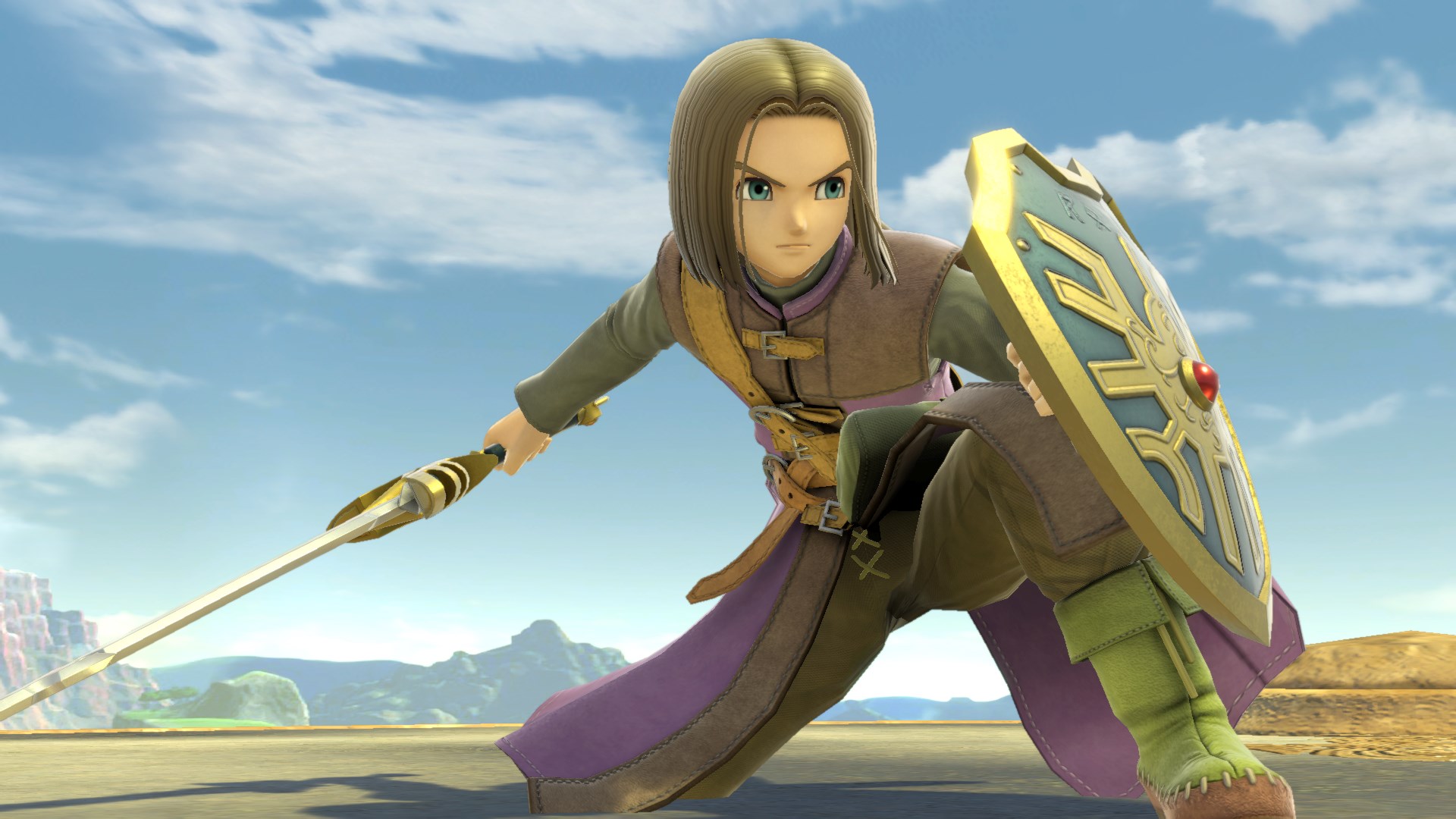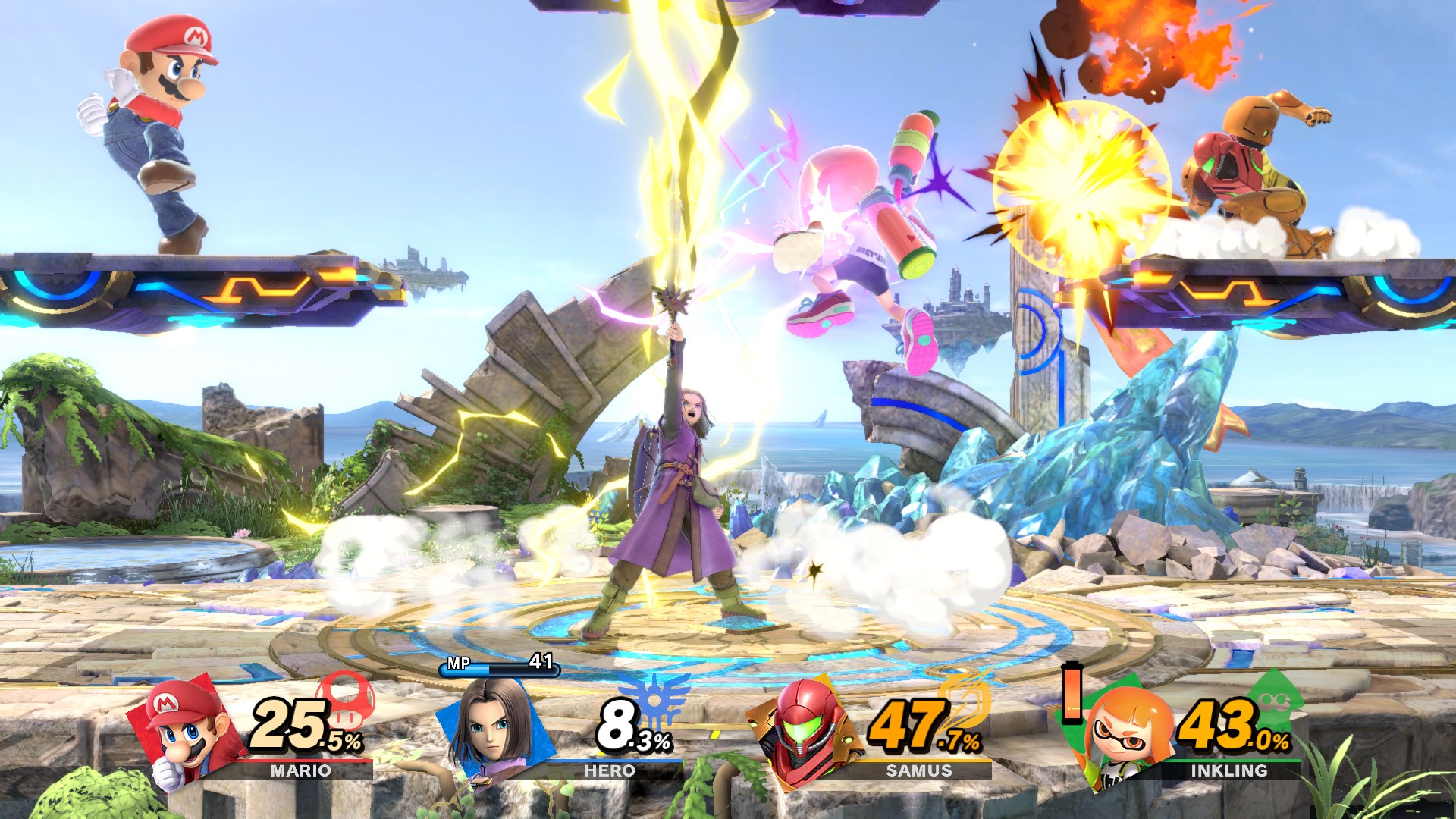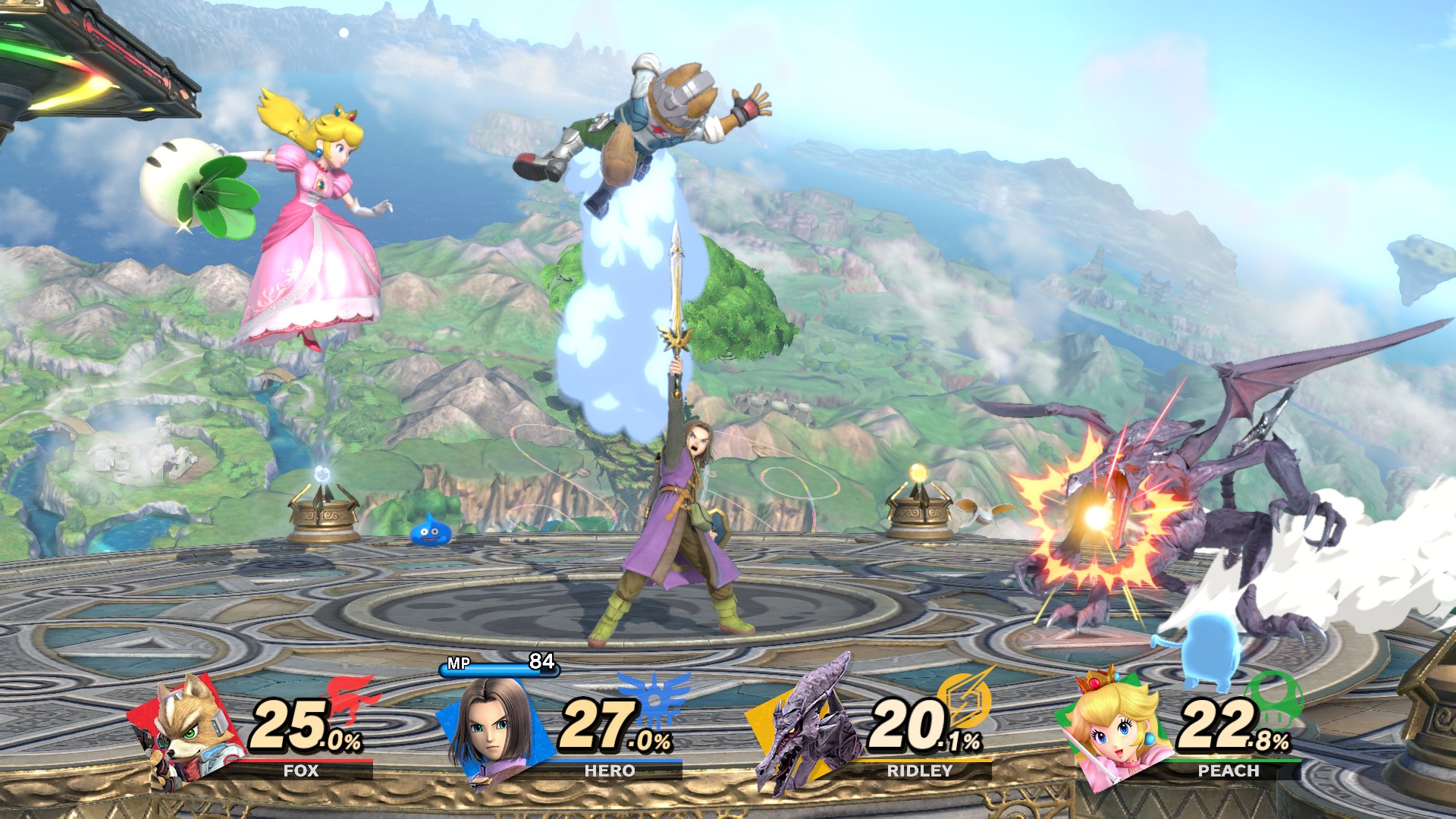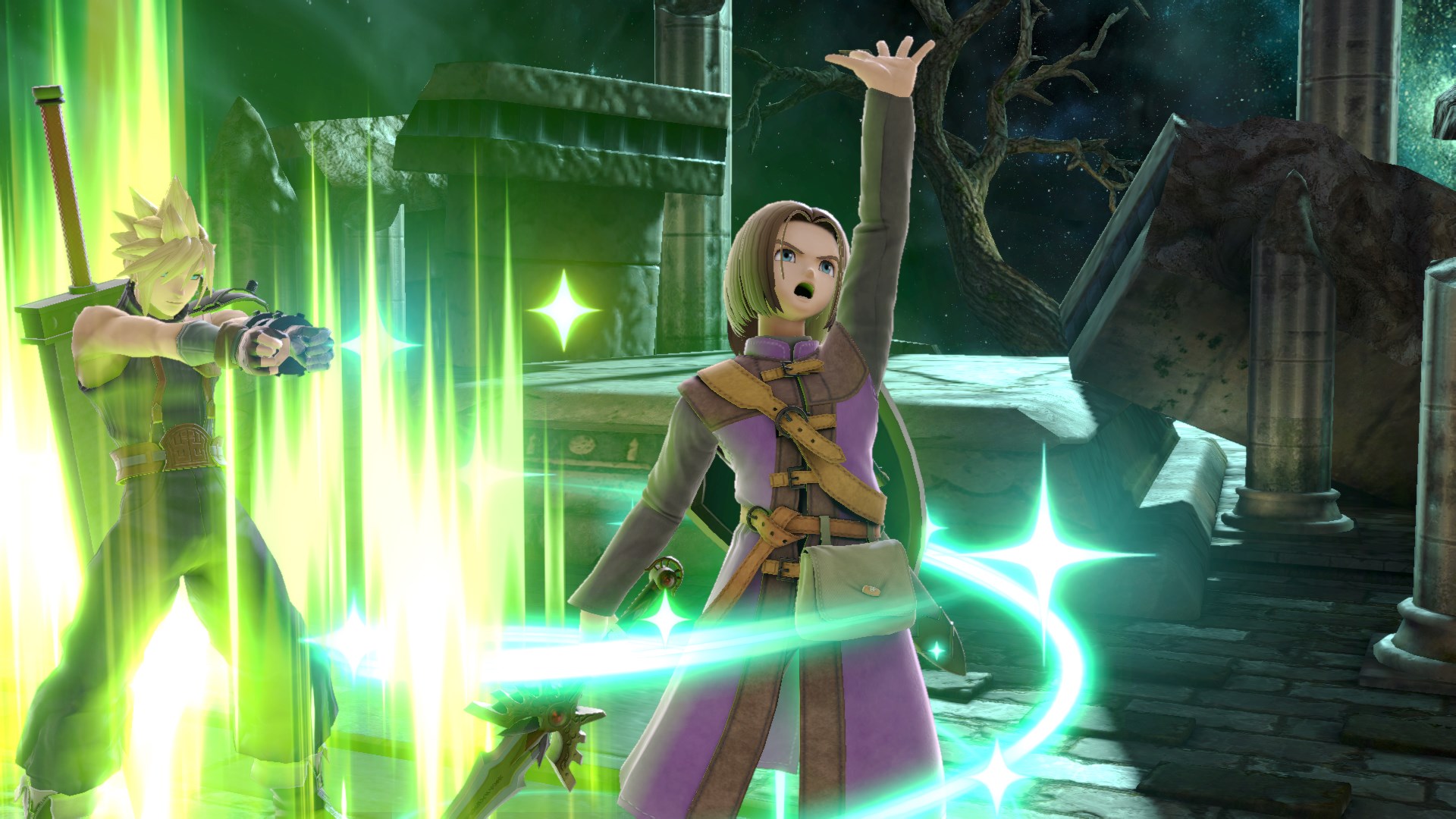
Hero is the latest character to enter the fray in Super Smash Bros. Ultimate, and he’s unlike any other addition prior. Hero comes from the Dragon Quest series and has some unique abilities that set him apart from the rest of the cast. These abilities have the competitive scene divided and already fans are debating online if he should be banned from competition.
Is Hero any good?
Let’s start off by getting this out of the way: Hero is a very good character. His moves are incredibly strong and he has great off-stage options. Think of Hero as a sword character similar to Ike, but with projectiles. That alone should be enough to see Hero rise the ranks of tier lists.
But should you play Hero? Probably. That is if you’re into slower character and prefer a more read-heavy style of play. If you’re the type of player that tries to predict what their opponent will do, then Hero could be a good fit. If you’re instead the type of player that prefers fast characters that overwhelm your opponent with moves, then maybe Joker or Lucina are better fits.
With that out of the way, let’s break down how to get the most out of Hero.
MP is eMPowering

You’ll notice that Hero has a meter next to his name. That’s his MP meter. MP is used when utilizing special moves, and recharges at one MP per second. Luckily, damaging your opponent fills MP at roughly one point per percentage damage given, which is handy as some moves use a lot more MP than others.
Ms. Frizzle

When a game starts, you should immediately start charging up Hero’s neutral-b. This is a massive fiery explosion known as Kafrizz that comes out fast and deals intense damage. We're talking upwards of 37.2% damage. This is more than enough to kill opponents at mid-percentage. It also has excellent range, meaning that if an opponent is trying to get back on stage from up high, you can jump up and throw it out. Even if it misses, it will put your opponent in a vulnerable position, limiting their stage landing options.
But this move, much like Samus’ charge shot, can be released at lower variables. Meaning that a quick tab of B will release frizz, a much weaker shot that only deals 9%. But it’s a good move that can push your opponent into a defensive position. A medium charge variant is also possible, known as frizzle, which deals 18% damage. Frizzle is the better option to go for over frizz.
Get instant access to breaking news, the hottest reviews, great deals and helpful tips.
15 specials
Did we mention that Hero is unlike any other Smash character? Well, when you press down-b, a menu pops up with four moves. There are 15 of these special moves total, and they pop up at random. I could go into every single move, but honestly, it’s not worth it. Yes, there are some incredibly powerful moves here, like Flame Slash or Kaboom, but pulling up the menu, selecting an attack, and releasing it is largely impractical. It simply takes too long.
Now, you can pull out the menu if the opponent is off stage, or further away. But in the heat of combat, you’d pretty much just be throwing out the first move on the menu at random. While some online were bemoaning the ridiculousness of a character with so many special moves, in actual practice it’s hard to match a certain move to a certain situation. Experiment and have fun with all these specials, but never rely on any of them in a tight pinch. It’s better to have your fundamentals down instead. And also, be careful of Kamikaze. Scroll down to the bottom for a full list of all of his spells.
Like trying to slice garlic with an axe

Hero’s biggest downside is his speed. Not his running speed; that’s actually surprisingly fast. It’s the speed at which his normal sword moves come out. Attacks have a slow animation and take a long time to come out, especially when compared to faster characters. For example, his forward-air (fair) takes 14 frames to start up. Compare that to Joker’s seven. Now, Hero does have some fast moves too, like his neutral-air (nair) which has an eight frame startup. Joker’s is 12 by comparison.
But overall, Hero’s moves are slower than faster members in the cast. In previous guides I mentioned a quick way to get out moves was to use short-hops coupled with a fast-fall along with an aerial c-stick move. This won’t really work for Hero as his moves take too long to come out. But you can still couple short-hops with c-stick aerial moves, you just can’t fast fall. And you’ll have to use the c-stick move almost immediately in the air. If you wait too long, Hero will land and the animation won’t connect. Every sword swipe must be deliberate and thought out.
Criticals
The most controversial inclusion to Hero’s moveset is his ability to land a critical hit. Roughly 12.5% of the time Hero can land a critical, dealing out major damage. This is frustrating for many in the competitive community as this randomness makes him an unfair character. Imagine a game of basketball where suddenly Steph Curry’s chances of landing a three-pointer double at random moments. Sure, it would be great for Golden State Warriors fans, but it would also be completely arbitrary. Either way, Hero players will have this insane advantage in games, and should capitalize on it.
Dash like you mean it
Hero’s running and dash game will be critical to his success. He has a very fast run speed, meaning players can dash back-and-forth with speed, which is great for spacing and creating a rhythm. This is referred to as dash dancing. His dash attack does 18% damage and can easily kill. The only downside is that there’s a long animation, meaning that you’ll have to press the attack button slightly earlier for it to land properly. It also means that it can be read, so don’t overuse it or your opponent will start to assume that if you’re running towards them, you’re about to use a dash attack. This is where dash-dancing can be handy. As you’re running towards your opponent, just run back. Sometimes it’s better for your opponent to attack first giving you an opportunity to counter. Force them to play at your pace, not theirs.
Neutral game

On the ground, Hero has a decent set of abilities. His triple jab, which is accomplished just by pressing the attack button three times, comes out moderately fast and can deal a total of 15% damage. That’s actually really solid. His forward-tilt, which can be activated by slightly tilting the directional stick forward and pressing attack, does six percent. But pressing the attack button again will throw out a second attack, totalling at 15.6% damage. Not bad. And Hero’s down-attack is a great combo starter.
Use Hero’s jab to create essentially a defense against oncoming opponents. It has decent range and opponents will not want to walk into those sword slashes.
Zap/Zapple/Kazap
Hero’s side-b is a good smack of electricity. Coupled with frizz, these two projectiles make Hero an incredible zoning character. Zapple is going to be the move with the most use in-game. It has excellent range and does a good amount of damage. The only downside is that it eats up a lot of MP.
Zap is a great off-stage option. If your opponent is flying off-stage, run after them and throw out a quick zap. It likely won’t kill, but will push them far enough making recovery difficult. Kazap is highly situational. It creates like an electricity tornado around Hero. But it needs to be charged up and can’t be stored. Once your opponent sees you charging up for a kazap, they’ll likely stay clear.
Woosh/Swoosh/Kaswoosh
Hero has an excellent recovery. Kaswoosh sends Hero flying up so far that he can be near the bottom blast zone in some cases. What’s also cool is that kaswoosh does damage. So, for example, you can land next to your opponent and use a quick woosh. This will send your opponent, even heavy opponents, flying upward, letting you connect with a quick fair or up-air. Kaswoosh on the other hand is great when your opponent is hanging on to the edge of the stage. Because of the way it does damage, it can be linked to a confirmed kill. Smash streamer Calvin “GimR” Lofton has a video detailing this combo.
Key combos

Neutral-down into nair/fair
A good bread-and-butter combo can have Hero running up and going straight into a down-attack on the ground. The opponent will fly up in such a way that you can hit them with a short-hop fair or a short-hor neutral (short-hop and just press the attack button). This combo works best when the opponent has a bit of percentage racked up as they will have longer hang time in the air.
Down-throw into fair
This is a safe combo that’s easy to learn and works at low percents. Grab your opponent, throw them down, and their forward trajectory sets you up perfectly for a fair.
Fair into jab
This is a really easy combo. Fair into your opponent really close, and as you land, press the attack button to throw out jab moves. This combo does 22.2% damage.
Pro tip! When jumping around on stage, charge your kafrizze at all times. To stop the charge, just press shield in the air, and you’ll hold on to whatever you charged. You can then continue charging later.
Fair into down-tilt string
At low percents, this is a good combo to rack up damage. You fair (or nair) close to your opponent, and as they’re in hit stun and you land on the ground, you press down on the analogue stick and press the attack button. The trajectory from the down-tilt will make your opponent fly upward making it possible to string another fair into another down-tilt. In training mode you can rack up 51% damage. But do know that in actual battle, your opponents will likely try to quickly shield or push themselves away from your attack range.
Fair into double up-tilt into up-air
Run at your opponent and hit them with a short-hop fair. As they fly away, get underneath them, and use up-tilt (in the settings turn tilt jump off to execute more easily) twice, and then as they fly higher, hit them with the up-air. This also works more easily on lighter characters.
Dair into up-smash
The cool thing about Hero’s dair is that not only can it spike off stage, on stage it gives enough hit-stun to give you enough time to follow up with an attack. Up-smash is a good option. But you can also up-tilt, grab, or jab.
Final thoughts

Hero is one of the most versatile characters I’ve seen in Smash for a while. Barring his attack speed, he has attacks and moves that cover so many options. The bread and butters above are a template for you. Practice and perfect those in training mode. But remember to always have your Kafrizz charged up. A lot of those bread and butters can combo into a Kafrizz, which should kill (or at least do a ton of damage).
If you’re wanting to jump into the competitive scene and enter some local tournaments, more likely than not, Hero will not be banned. There have been very few banned characters in competitive Smash history, and even then, those characters were only temporarily banned.
Lastly, because this character is so dynamic, be sure to watch some tournament videos on YouTube. Top players will continue to unlock more strategies with Hero. I can see each tournament bringing in new innovations for at least a few years. There’s that much potential with this character. This guide is here to help you get your fundamentals. Enough to get yourself riding on a skateboard and doing an ollie. Once you’ve mastered everything here, then it’ll be time to go wild.
Hero's down-b spells (in alphabetical order)
- Accelerattle: Movement speed up
- Bounce: Deflects projectiles
- Flame Slash: Large sword attack
- Heal: Restores health
- Hocus Pocus: Random effect
- Kaboom: Explosive spell
- Kaclang: Invisibility when stationary
- Kacrackle Slash: Freeze opponents
- Kamikazee: Self-destruct and inflict damage
- Metal Slash: Chance to One-Hit KO a metal opponent
- Oomph: Raises attack power temporarily
- Psyche Up: Increased power of next attack
- Snooze: Puts opponents to sleep, delivers a critical attack when hitting said opponent
- Thwack: Chance to KO an opponent in one hit. Percentage change is higher at higher DMG
- Zoom: Warp back to stage

Imad is currently Senior Google and Internet Culture reporter for CNET, but until recently was News Editor at Tom's Guide. Hailing from Texas, Imad started his journalism career in 2013 and has amassed bylines with the New York Times, the Washington Post, ESPN, Wired and Men's Health Magazine, among others. Outside of work, you can find him sitting blankly in front of a Word document trying desperately to write the first pages of a new book.
